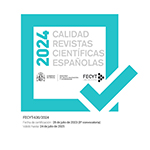El derecho y la revolución copernicana de Marx (Notas para un derecho científico a partir de ·El orden de El capital", de Carlos Fernández Liria y Luis Alegre Zahonero)
Abstract
A partir de la premisa de que la teoría económica de Marx instauró un giro copernicano en las ciencias sociales, el presente artículo analiza la posibilidad de derivar un sistema de derecho que mereciese ser llamado “científico”, en tanto que estaría en consonancia con las tesis básicas de dicha teoría. En este contexto, el artículo polemiza contra lo recientemente defendido por Fernández Liria y Alegre Zahonero porque –frente a ellos– sostiene que el derecho resultante de tomar en cuenta las tesis marxianas sería incompatible con las formulaciones jurídicas de la Ilustración. Tal incompatibilidad se debería, sobre todo, a que los conceptos ilustrados de “igualdad”, “libertad” y “autonomía” hallan el sujeto de su aplicación en el “individuo”. En cambio, puesto que el objeto de estudio específico de la teoría marxiana son los medios sociales de producción, de su análisis económico sólo podría derivarse “la clase” como sujeto jurídico, no el individuo. Finalmente, el artículo sugiere que esta dimensión individual (faltante en la teoría de Marx) sólo podría introducirse en un derecho científico en caso de fundarse sobre el otro giro copernicano que encontramos en las ciencias sociales, aunque esta vez en la psicología: el psicoanálisis de Freud.Downloads
##submission.format##
Licenza
La revista Logos. Anales del Seminario de Metafísica, para fomentar el intercambio global del conocimiento, facilita el acceso sin restricciones a sus contenidos desde el momento de su publicación en la presente edición electrónica, y por eso es una revista de acceso abierto. Los originales publicados en esta revista son propiedad de la Universidad Complutense de Madrid y es obligatorio citar su procedencia en cualquier reproducción total o parcial. Todos los contenidos se distribuyen bajo una licencia de uso y distribución Creative Commons Reconocimiento 4.0 (CC BY 4.0). Esta circunstancia ha de hacerse constar expresamente de esta forma cuando sea necesario. Puede consultar la versión informativa y el texto legal de la licencia.











